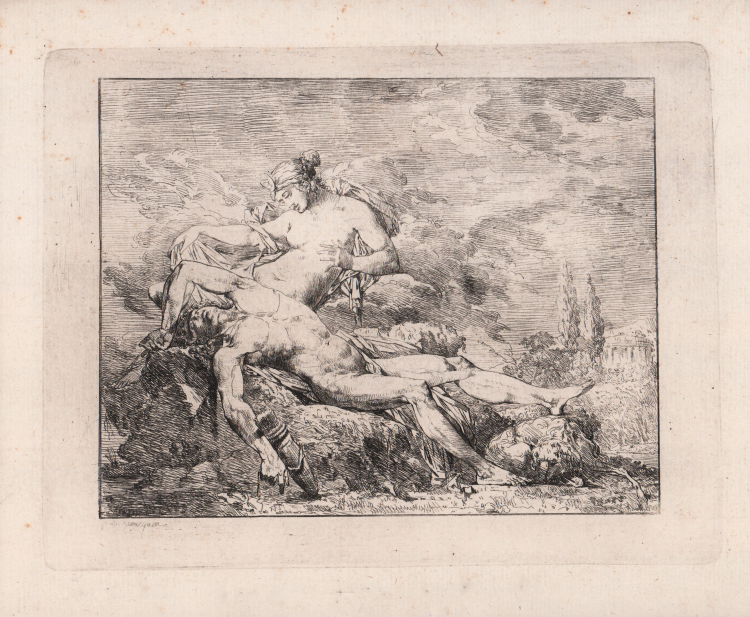- New




| Reference: | S47167 |
| Author | Philippe-Auguste Hennequin |
| Year: | 1790 ca. |
| Measures: | 215 x 165 mm |



| Reference: | S47167 |
| Author | Philippe-Auguste Hennequin |
| Year: | 1790 ca. |
| Measures: | 215 x 165 mm |
Etching, last quarter of the 18th century, signed on the plate lower left.
Beautiful work, printed on contemporary laid paper, with margins, in perfect condition.
The work illustrates the myth of Diana, goddess of the moon and the hunt, who falls in love with the handsome shepherd Endymion. In classical iconography, Diana is often depicted visiting Endymion, who lies in an eternal sleep, granted to him by Zeus to preserve his youth and beauty. This myth poetically explains the phases of the moon and the love between a deity and a mortal.
The painter and printmaker Philippe-Auguste Hennequin studied under Jacques-Louis David, which prompted Jules Renouvier (J. Renouvier, Histoire de l’art pendant la Révolution, Paris 1863) to remark that "he had embraced his master's academic principles with the same rigor as his revolutionary sentiments".
After completing his training, Hennequin was a pensioner at the French Academy in Rome, but was forced to flee Italy in 1789 due to revolutionary activities and subsequently worked as a painter in Paris and Lyon. Hennequin was arrested during the repression that followed 9 Thermidor (July 27, 1794) and escaped execution only thanks to the good offices of the politician François de Neufchãteau. From then on, Hennequin stayed away from any form of political activity, working exclusively as a painter during the Empire. Hennequin created monumental battle scenes at the request of Bonaparte and enjoyed the protection of Vivant-Denon. The artist, however, remained faithful to his political convictions, joining his master David in exile in Belgium after the return of the Bourbons in 1815.
Hennequin's engravings date from his early period and are extremely rare. Renouvier records a total of five.
Bibliografia
Inventaire du Fonds Français, 3.
Philippe-Auguste Hennequin (Lione, 10 agosto 1762 – Leuze-en-Hainaut, 12 maggio 1833)
|
French painter specializing in historical painting and portraiture.
A pupil of the Swedish painter Per Eberhard Cogell (1734-1812) in Lyon, then in Paris a pupil of David, he went to Rome thanks to an English patron, but was forced to leave the city because of the anti-French riots of 1793. Under the First French Empire he painted a large production of historical works, such as Awarding of the Légion d'Honneur to Napoleon Bonaparte for the invasion of England (1806), The Battle of the Pyramids (1806) and the 4x6 metre painting The Triumph of the French People on August 10th (which in 1799, won first prize at the Paris Salon and was then cut up and divided between the museums of Rouen, Angers, Le Mans and Caen in 1820. Under the French Restoration, he returned from self-imposed exile in Belgium, where he had been director of the Academy of Tournai, although he later died in poverty. Many of his works were lost in the 1820s. drawings are kept at the Museum of Fine Arts in Lyon.
|
Philippe-Auguste Hennequin (Lione, 10 agosto 1762 – Leuze-en-Hainaut, 12 maggio 1833)
|
French painter specializing in historical painting and portraiture.
A pupil of the Swedish painter Per Eberhard Cogell (1734-1812) in Lyon, then in Paris a pupil of David, he went to Rome thanks to an English patron, but was forced to leave the city because of the anti-French riots of 1793. Under the First French Empire he painted a large production of historical works, such as Awarding of the Légion d'Honneur to Napoleon Bonaparte for the invasion of England (1806), The Battle of the Pyramids (1806) and the 4x6 metre painting The Triumph of the French People on August 10th (which in 1799, won first prize at the Paris Salon and was then cut up and divided between the museums of Rouen, Angers, Le Mans and Caen in 1820. Under the French Restoration, he returned from self-imposed exile in Belgium, where he had been director of the Academy of Tournai, although he later died in poverty. Many of his works were lost in the 1820s. drawings are kept at the Museum of Fine Arts in Lyon.
|